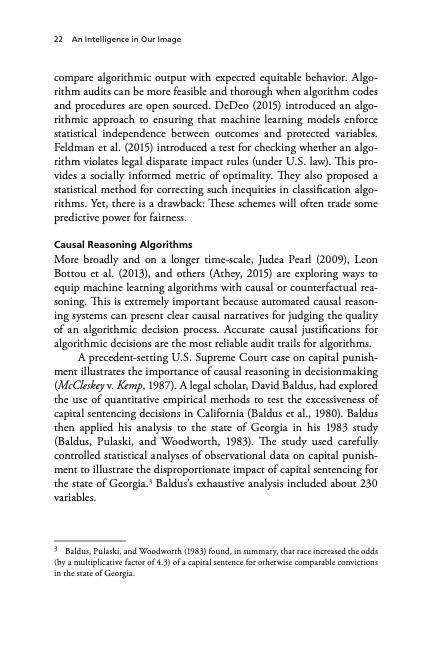
PDF Publication Title:
Text from PDF Page: 032
22 An Intelligence in Our Image compare algorithmic output with expected equitable behavior. Algo- rithm audits can be more feasible and thorough when algorithm codes and procedures are open sourced. DeDeo (2015) introduced an algo- rithmic approach to ensuring that machine learning models enforce statistical independence between outcomes and protected variables. Feldman et al. (2015) introduced a test for checking whether an algo- rithm violates legal disparate impact rules (under U.S. law). This pro- vides a socially informed metric of optimality. They also proposed a statistical method for correcting such inequities in classification algo- rithms. Yet, there is a drawback: These schemes will often trade some predictive power for fairness. Causal Reasoning Algorithms More broadly and on a longer time-scale, Judea Pearl (2009), Leon Bottou et al. (2013), and others (Athey, 2015) are exploring ways to equip machine learning algorithms with causal or counterfactual rea- soning. This is extremely important because automated causal reason- ing systems can present clear causal narratives for judging the quality of an algorithmic decision process. Accurate causal justifications for algorithmic decisions are the most reliable audit trails for algorithms. A precedent-setting U.S. Supreme Court case on capital punish- ment illustrates the importance of causal reasoning in decisionmaking (McCleskey v. Kemp, 1987). A legal scholar, David Baldus, had explored the use of quantitative empirical methods to test the excessiveness of capital sentencing decisions in California (Baldus et al., 1980). Baldus then applied his analysis to the state of Georgia in his 1983 study (Baldus, Pulaski, and Woodworth, 1983). The study used carefully controlled statistical analyses of observational data on capital punish- ment to illustrate the disproportionate impact of capital sentencing for the state of Georgia.3 Baldus’s exhaustive analysis included about 230 variables. 3 Baldus, Pulaski, and Woodworth (1983) found, in summary, that race increased the odds (by a multiplicative factor of 4.3) of a capital sentence for otherwise comparable convictions in the state of Georgia.PDF Image | Intelligence in Our Image Risks of Bias and Errors in Artificial Intelligence

PDF Search Title:
Intelligence in Our Image Risks of Bias and Errors in Artificial IntelligenceOriginal File Name Searched:
RAND_RR1744.pdfDIY PDF Search: Google It | Yahoo | Bing
Cruise Ship Reviews | Luxury Resort | Jet | Yacht | and Travel Tech More Info
Cruising Review Topics and Articles More Info
Software based on Filemaker for the travel industry More Info
The Burgenstock Resort: Reviews on CruisingReview website... More Info
Resort Reviews: World Class resorts... More Info
The Riffelalp Resort: Reviews on CruisingReview website... More Info
| CONTACT TEL: 608-238-6001 Email: greg@cruisingreview.com | RSS | AMP |